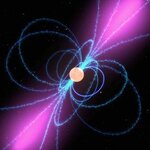Space

Physicists of the University of Granada and the University of Valencia (Spain) have developed a proceeding to analyse specific data sent by the Huygens probe from Titan, the largest moon of Saturn, proving “in an unequivocal way” that there is natural electric activity in its atmosphere. The scientific community thinks that there is a higher probability that organic molecules precursors to life could form in those planets or satellites which have an atmosphere with electric storms.
Researcher Juan Antonio Morente, from the Department of Applied Physics of the University of Granada, has…

A new image released by ESO shows the amazing intricacies of a vast stellar nursery, which goes by the name of Gum 29. In the center, a small cluster of stars — called Westerlund 2 — has been found to be the he home of one of the most massive double star systems known to astronomers.
Gum 29 is a huge region of hydrogen gas that has been stripped of its electrons (ionized) by the intense radiation of the hot young stars located at its centre. Astronomers call this an HII (pronounced "H-two") region, and this particularly stunning example stretches out across space for over 200 light-years. The…

A bit of serendipity has given astronomers a surprise view of a never-before-observed event in the birth of a galaxy.
University of Florida and University of California-Santa Cruz astronomers are the first to discover the onset of a huge flow of gas from a quasar, or the super-bright core of an extremely remote young galaxy still being formed. The gas was expelled from the quasar and its enormous black hole sometime in the space of four years around 10 billion years ago – an extremely brief and ancient blip noticed only by a sharp-eyed undergraduate and the unlikely convergence of two…

About three times a second, a 10,000-year-old stellar corpse sweeps a beam of gamma-rays toward Earth. This object, known as a pulsar, is the first one known to "blink" only in gamma rays, and was discovered by the Large Area Telescope (LAT) onboard NASA's Fermi Gamma-ray Space Telescope, a collaboration with the U.S. Department of Energy (DOE) and international partners.
"This is the first example of a new class of pulsars that will give us fundamental insights into how stars work," says Stanford University's Peter Michelson, principal investigator for the LAT. The LAT data is processed by…

Astronomers think that many - perhaps all - galaxies in the universe contain massive black holes at their centers. New observations with the Submillimeter Array now suggest that such colossal black holes were common even 12 billion years ago, when the universe was only 1.7 billion years old and galaxies were just beginning to form. The new conclusion comes from the discovery of two distant galaxies, both with black holes at their heart, which are involved in a spectacular collision.
4C60.07, the first of the galaxies to be discovered, came to astronomers' attention because of its bright radio…

Scientists have detected long wavelength radio emissions from a colliding, massive galaxy cluster which, surprisingly, is not detected at the shorter wavelengths typically seen in these objects.
The discovery implies that existing radio telescopes have missed a large population of these colliding objects. It also provides an important confirmation of the theoretical prediction that colliding galaxy clusters accelerate electrons and other particles to very high energies through the process of turbulent waves.
This new population of objects is most easily detected at long wavelengths.…

Hot, young planets may be easier to spot because they stay that way longer than astronomers have thought, according to new work by MIT planetary scientist Linda Elkins-Tanton.
For a few million years after their initial formation, planets like Earth may maintain a hot surface of molten rock that would glow brightly enough to make them stand out as they orbit neighboring stars. Elkins-Tanton, Mitsui Career Development Professor of Geology in the Department of Earth, Atmospheric and Planetary Sciences, says the “magma ocean” stage for Earth-sized planets may last a few million years, much…

Sitting atop the Big Island of Hawaii is majestic Mauna Kea, Hawaii’s largest volcano and also the site of the latest test site for NASA’s new moon probe, Scarab. Its mission: lunar prospecting.
Although the inactive volcano may not seem to resemble the moon, Mauna Kea does provide a similar environment to field test the robot for a mission to the moon. Mauna Kea has rocky slopes and, due to its elevation, cold temperatures. Mauna Kea is a paradise to many a migrating astronomer and, with its 14,000-foot summit, is often covered in snow. NASA will field test Scarab at 9,000 feet, where it…

Astronomers using the James Clerk Maxwell Telescope (JCMT) in Hawaii are making new discoveries about the origins of the planets, stars and galaxies with the start of a new survey to map the Universe.
The JCMT Legacy Survey, made up of 7 projects, makes use of two sophisticated new instruments - SCUBA-2 and HARP – which will allow the astronomers to detect and probe clouds of cold dust associated with the mysterious earliest phases of the formation of galaxies, stars and planets.
SCUBA-2 is a powerful camera capable of mapping regions of the sky by detecting the heat emitted by this extremely…

Venus Express looking back on Earth
Credits: ESA/VIRTIS/INAF-IASF/Obs. de Paris-LESIA (Earth views: Solar System Simulator JPL-NASA)This image composite shows the signatures of methane (CH4), carbon dioxide (CO2), ozone (O3) and nitrous oxide (N2O), minor species of the Earth’s atmosphere but powerful greenhouse gases, detected by the Visual and Infrared Thermal Imaging Spectrometer (VIRTIS) on board ESA’s Venus Express at infrared wavelengths, while the spacecraft was pointing Earth along its orbit around Venus. Our planet was just a pixel in VIRTIS’s field of view
Venus Expess, the…